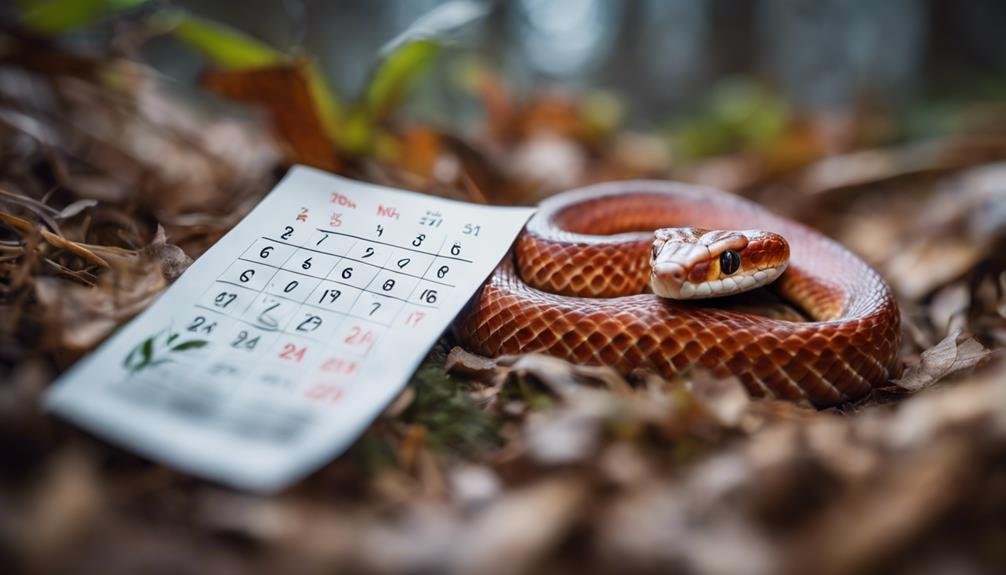You've probably wondered if your corn snake hibernates during the cold months, similar to how bears do. Well, they don't hibernate but go through a fascinating process known as brumation. This state of dormancy is essential for their survival, allowing them to conserve energy when the environment doesn't favor their usual active lifestyle. But what exactly triggers brumation, and how does it differ from the hibernation of warm-blooded animals? Understanding this could not only enlighten you about your pet's natural behaviors but also enhance your care for them during these less understood periods. Let's uncover the mystery behind why corn snakes brumate and the implications it has on their overall health and well-being.
Key Takeaways
- Corn snakes enter brumation, a dormancy state similar to hibernation, not true hibernation.
- Brumation is triggered by cooler temperatures and shorter daylight hours.
- During brumation, a corn snake's metabolism slows down to conserve energy.
- This process is vital for the snake's survival through colder months and for mating readiness.
- In captivity, brumation can be induced by gradually lowering the enclosure's temperature.
Understanding Brumation
Brumation, a survival tactic akin to hibernation, allows corn snakes to endure the chill of winter by entering a state of dormancy. This period of reduced activity enables them to conserve energy and maintain health when temperatures drop. Unlike mammals that hibernate to escape the cold, corn snakes brumate, slowing their metabolism without falling into a deep sleep. In the wild, this process is natural, triggered by the changing seasons. However, in captivity, you can induce brumation by gradually lowering the temperature in their habitat to around 65°F.
During brumation, it's crucial to reduce feeding since their digestive system slows down significantly, making it hard for them to process food. Instead, you'll need to make sure they've access to water to stay hydrated throughout this period. Mature adult corn snakes, particularly those bred for reproductive purposes, are usually the ones subjected to brumation. This period of dormancy isn't just a survival mechanism but also a critical part of their breeding cycle, preparing them for the spring when they emerge ready to mate.
Hibernation Vs. Brumation
Now that you understand what brumation is, let's explore how it differs from hibernation, particularly in species like corn snakes. Brumation is a vital process that allows reptiles, including your corn snake, to survive the colder months. Unlike mammals that hibernate, corn snakes and other reptiles don't build up fat reserves before entering this dormant state. Instead, they rely on brumation, a period during which their metabolism slows but doesn't stop completely, allowing them to make it through without the need for extensive food stores.
Hibernation and brumation may seem similar at first glance because both involve a period of inactivity during colder weather. However, the biological adaptations behind them are quite distinct. While mammals will eat heavily before hibernating to build up fat reserves, corn snakes and their reptilian kin do not. This difference is important for understanding how to care for them during the cooler months.
It's also interesting to note that not all snakes brumate. Some species, depending on their habitat, may opt for estivation to escape extreme heat instead of brumating. However, North American species like the garter snake and corn snake are known to commonly brumate, whether in the wild or in captivity, adapting to the changing seasons without the need for a deep, hibernation-like sleep.
The Biology of Brumation
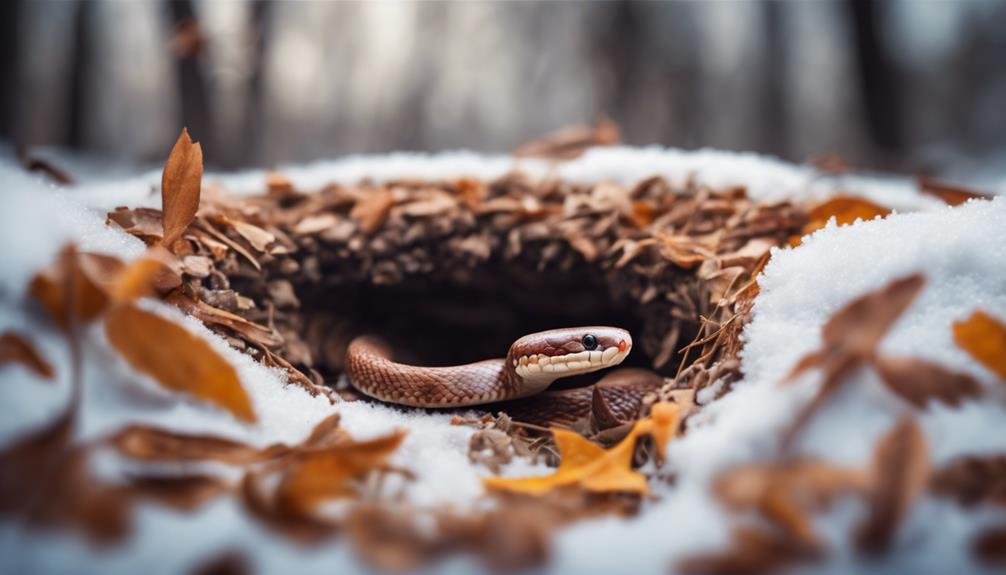

Understanding the biology of brumation in Corn Snakes is essential as you explore how it differs from hibernation.
You'll learn what triggers this state in your pet and recognize the signs that indicate they're entering brumation.
This knowledge is key to ensuring their health and well-being during these cooler months.
Brumation Vs. Hibernation
Exploring the biology of brumation, it's important to understand how this reptilian adaptation differs greatly from mammalian hibernation. Unlike hibernation, where animals like bears bulk up on fat to survive the winter, Corn Snakes and other reptiles take a different approach to cold weather survival.
- Brumation involves slowing down metabolic processes, rather than accumulating fat reserves.
- During this period, Corn Snakes lower their activity levels considerably.
- Their heart rate and metabolism also decrease to conserve energy.
- This adaptation allows them to endure colder conditions without the need for active hunting.
- It's a survival strategy to conserve energy during harsh winter conditions when food is scarce.
Understanding these differences highlights the unique biological strategies reptiles have developed to thrive in their environments.
Brumation Triggers in Corn Snakes
As temperatures drop and days grow shorter, Corn Snakes begin their brumation process, an essential adaptation for conserving energy and maintaining reproductive health. Brumation triggers in these reptiles are fascinating, driven by the natural changes in their environment.
| Trigger | In the Wild | In Captivity |
|---|---|---|
| Temperature | Decreases | Controlled decrease |
| Daylight | Shortens | Artificial light adjustment |
| Activity Level | Reduces | Observably lower |
| Metabolic Rate | Drops | Markedly reduced |
| Reproductive Prep | Enhances | Mimicked conditions |
You'll notice that whether in the wild or in a carefully controlled captivity setting, the cues for brumation remain consistent. This period is vital, not just for energy conservation but also for ensuring that Corn Snakes are ready for future mating seasons, preserving their reproductive health and sperm viability.
Signs of Brumation
To recognize when a Corn Snake is entering brumation, look for signs such as a significant drop in activity and a preference for secluded hiding spots. During this period, your snake's behavior changes as it conserves energy for survival. Here's what to watch for:
- A noticeable decrease in activity; your snake may become less interested in exploring its enclosure.
- Seeking out cooler, secluded spots within its habitat, indicating it's preparing for a period of dormancy.
- Refusal of food, as their metabolism slows, and they require less energy.
- Reduced bowel movements, due to lower food intake and metabolic rate.
- Overall slower movements, as their body temperature drops and bodily functions slow down.
Understanding these signs of brumation can help you provide better care for your Corn Snake during this natural process.
Environmental Triggers
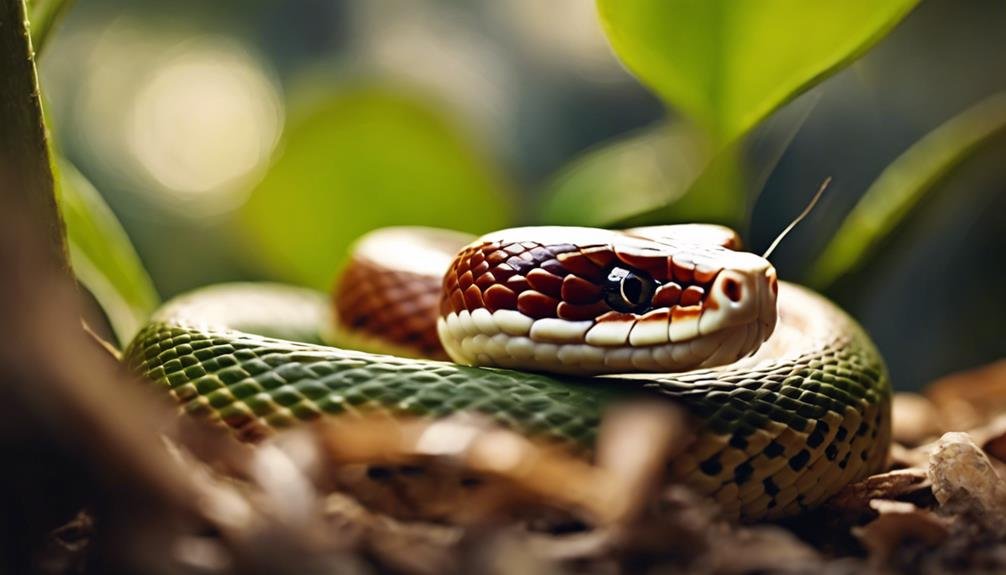

As you explore how corn snakes enter hibernation, you'll find that temperature drops and reduced daylight hours play a critical role. These environmental triggers signal your corn snake to slow down and prepare for brumation.
Understanding these cues can help you mimic their natural conditions, even in captivity.
Temperature Drops Impact
Temperature drops and shorter daylight hours serve as important environmental triggers signaling corn snakes it's time to enter brumation. When the temperature starts to fall, it cues these reptiles to slow down and prepare for a period of dormancy. This natural response to cooler climates allows corn snakes to conserve energy during times when food is scarce and conditions are harsh.
- Temperature drops signal the onset of brumation.
- Lower temperatures slow the snake's metabolism.
- Brumation helps conserve energy during cold months.
- Environmental cues trigger this survival mechanism.
- This period of dormancy is critical for survival in winter.
Understanding these triggers is essential for anyone caring for or studying corn snakes, as it impacts their health and behavior during colder seasons.
Daylight Hours Reduction
Just like the drop in temperature, the decrease of daylight hours plays a significant role in signaling corn snakes to enter brumation. This daylight hours reduction is vital for kicking off the brumation process.
When the days get shorter, your corn snake senses it's time to slow things down. This decrease in light exposure cues your pet to prepare for a period of lowered activity, mimicking the natural conditions they'd experience in the wild.
It's not just about cooler temperatures; the consistent reduction in daylight is essential for triggering the physiological changes necessary for brumation. These changes help your snake conserve energy by slowing its metabolism.
Successfully inducing brumation in captive corn snakes requires carefully reducing light exposure, just as much as managing temperatures.
Preparing for Brumation
To properly prepare your Corn snake for brumation, start by gradually lowering the habitat's temperature to around 65°F. This process mimics the natural cooling that your Corn snake would experience in the wild as seasons change from warm to cold. It's important to make sure that your snake is ready for this period of dormancy, both to maintain its health and to mimic natural cycles that can benefit breeding.
- Stop feeding your Corn snake two weeks before beginning the temperature reduction. This allows your snake to digest any remaining food in its system, as digestion slows down greatly during brumation.
- Ensure the snake has access to water. Hydration is crucial, even during brumation, so make sure fresh water is always available.
- Only brumate mature adult Corn snakes. Younger snakes may not have the reserves to safely undergo brumation.
- Monitor the temperature closely. Gradually decrease the habitat's temperature over a few weeks to avoid shocking your snake's system.
- Prepare for a post-brumation shed, especially in females. This is particularly important if you're planning to breed your Corn snakes after brumation, as shedding is a sign of good health and readiness for mating.
Brumation in Captivity
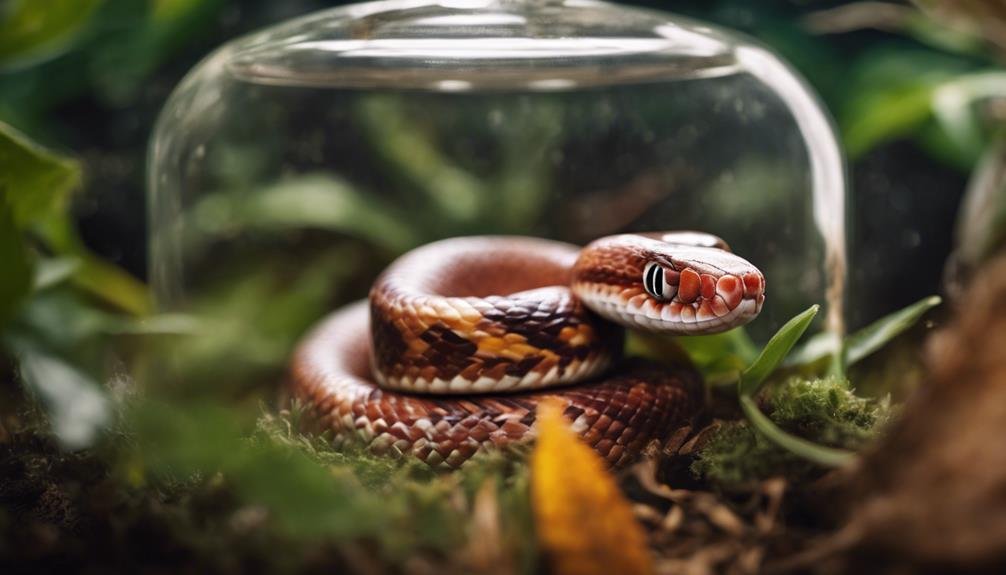

When you lower the enclosure's temperature gradually, you can induce brumation in captive Corn snakes, although not every snake will enter this state. It's important to understand that brumation in captive snakes isn't as common as you might see with other reptiles, such as bearded dragons or tortoises. This difference doesn't mean your Corn snake won't need or benefit from a period of brumation; it simply means that as a caretaker, you'll need to pay close attention to your snake's behavior and health during this time.
Proper care and monitoring become vital when you're managing brumation in captivity. You're essentially mimicking the cooler, winter conditions these snakes would experience in the wild, which can trigger their natural brumation behavior. Even if you maintain consistent temperatures in the enclosure, don't be surprised if your captive snake still exhibits signs of wanting to brumate, following their internal, seasonal clock.
It's a balancing act, ensuring the health and safety of your captive snakes during this period. Remember, not all will choose to brumate, but for those that do, your careful management of their environment plays a pivotal role in their overall wellbeing.
After Brumation Care
After your Corn snake has undergone brumation, it's important to gradually increase enclosure temperatures to safely awaken them. This gentle shift helps your snake adjust back to its active state without stress. As they emerge from brumation, your attention to their needs guarantees a smooth return to normal activity levels. Here's a concise guide to help you through this critical period:
- Gradually increase temperatures to your snake's normal living conditions over several days to avoid shocking their system.
- Offer water immediately after brumation to help your snake rehydrate. Dehydration can be a concern, and fresh water encourages them to drink.
- Wait for them to shed their skin before offering food. This post-brumation shed is a sign they're ready to resume normal feeding routines.
- Monitor closely for signs of illness or stress as they adjust. Any unusual behavior might indicate a need for veterinary attention.
- Resume feeding slowly to prevent digestive issues. Start with smaller meals and gradually return to their regular feeding schedule.
Common Questions Explained
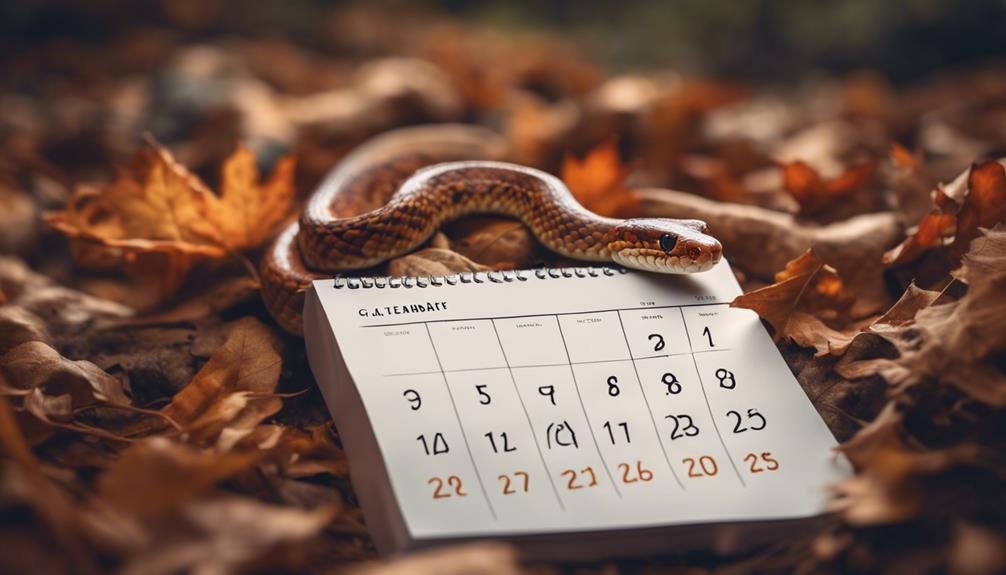

Understanding the nuances of Corn snake brumation often leads to numerous questions, especially for new owners seeking to provide excellent care. You might wonder why snakes hibernate in the wild but don't necessarily need to in captivity. It's because, in the wild, brumation allows Corn snakes to survive the cold by slowing their metabolism, conserving energy for warmer times. However, in your home, consistent, comfortable temperatures make this process unnecessary for survival.
Yet, if you're a breeder, you'll find brumation can be quite advantageous. It's mainly mature adult Corn snakes that undergo this process to help mimic natural seasonal changes, enhancing breeding success and fertility. The key here is the gradual reduction of temperatures to around 65°F, ensuring only water is provided during this time. This careful approach to brumation can greatly increase the chances of successful breeding, answering why it's a practiced method despite not being essential for all snakes in captivity.
How Does Hibernation Affect Corn Snakes as Pets?
The pros and cons of corn snakes hibernating as pets can vary. While hibernation can be a natural and healthy process for corn snakes, it can also be concerning for pet owners who may worry about their snake’s health. Understanding the specific needs of corn snakes during hibernation is key for ensuring their well-being.
Conclusion
To sum up, you've learned that corn snakes don't hibernate but enter brumation, a dormancy phase for energy conservation during colder months. Unlike hibernation, they don't need to bulk up on fat but instead slow down their metabolism in response to environmental changes.
Whether in the wild or captivity, understanding brumation is essential for their care, especially when it comes to preparing for and recovering from this period. Now you're better equipped to support your corn snake through its natural cycles.

